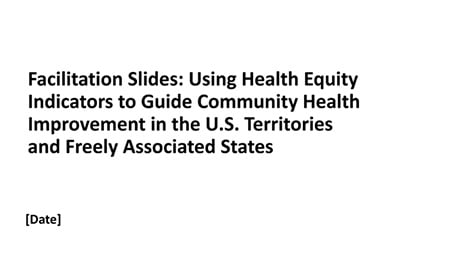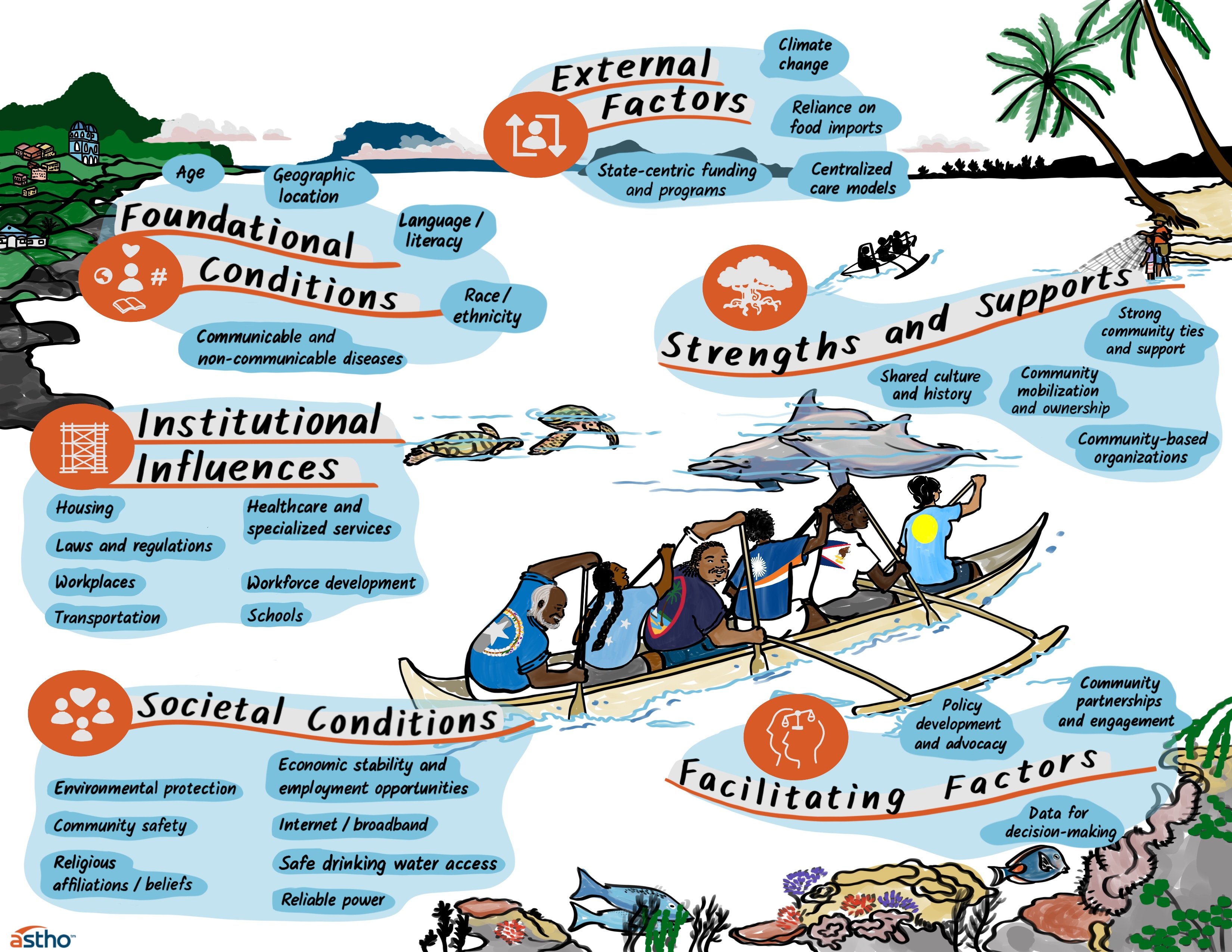Using Health Equity Indicators to Guide Community Health Improvement in U.S. Territories and Freely Associated States
August 14, 2024
Take It To Go
The full version of this ASTHOReport is available as a PDF download—it has additional actionable tips, visuals, a comprehensive list of resources, citations, and more.
Health equity metrics play an integral role in the island areas’ work to achieve health equity efforts. As public health agencies in the U.S. territories and freely associated states begin to define their vision and advance their health equity work, health equity metrics help to understand issues impacting communities, monitor progress on efforts, and explore opportunities for improvement.
ASTHO’s step-by-step guide, which aligns with the Islands Health Equity Framework, serves as a roadmap for establishing a shared understanding of health equity, identifying and developing health equity indicators and measures, and tracking the progress of health equity efforts. This guide and key resources, including a slide deck, support conversations focused on health equity efforts as island area public health agencies engage with staff and communities served.
This guide can be used to:
- Begin to establish and communicate a shared understanding of health equity.
- Explore opportunities to examine health indicators through a health equity lens.
- Direct integration of health equity indicators into health agency plans.
- Scale up a plan for measuring health equity.
Data
ASTHO’s Islands Health Equity Framework provides a foundation to support the development of health equity indicators and measures. Appendix B of the guide, which starts on page 20, explores potential topic areas for indicators based off the six key areas of this framework. Also included are corresponding available data sources that can help assess health equity within and across island areas. Review Appendix B and start exploring that data now.
Steps to Action
The following six steps outline actions that can help establish a shared foundation to achieve health equity, and identify and develop health equity metrics using local and representative data. Agencies can use the metrics, including indicators and measures, to explore opportunities for improvement and to track progress on efforts to achieve health equity. To achieve health equity in island areas, work through these steps in collaboration with staff, practitioners, and community experts to advance local action. Consider how each of these steps promotes achieving health equity as well as monitoring and sustaining advancements in health equity.
The following is a snapshot; download the full guide for more detailed information about each of the steps, including additional tools and resources.
Step One: Build Shared Understanding
ASTHO’s definition of health equity lays the foundation for our external work: "Health equity is when everyone has a fair and just opportunity to be as healthy as possible in a society that values each member equally through focused and ongoing efforts to address avoidable inequities and historical and contemporary injustices and eliminate disparities in health and health care." Consider the various definitions of health equity within and among island areas. Achieving health equity requires building a shared understanding of concepts and language to help advance efforts and collaborative action to improve health and well-being for all.
Step One in Action:
- Build the concept of health equity within public health agencies.
- Engage island areas public health partners to help facilitate discussions.
- Engage the community.
Step Two: Frame Health Equity
Reframe the issues to resonate with community members, partners, and other island areas collaborators.
Step Two in Action:
- Focus on health equity rather than health disparities.
- Frame health equity as achievable.
- Communicate to address stigma.
- Meet the community where they are.
- Communicate health equity as a "we" issue.
- Build island areas public health agency staff capacity to understand health equity.
Step Three: Identify and Develop Indicators Through a Health Equity Lens
Agencies can measure health equity by exploring existing health indicators and developing new ones. Before developing new indicators, use a health equity lens to explore equity within existing datasets and across indicators of health status, social determinants of health, and other community-level factors that influence health and well-being.
Step Three in Action:
- Identify what is important to measure.
- Select existing indicators and measures. Refer to pages 11-12 in the guide for examples of how to apply a health equity lens to existing health indicators.
- Develop new indicators and measures. See pages 11-12 in the guide in the guide for examples of health equity indicators that could be tailored to an island jurisdiction context. Although these are examples and not tied to any existing data sources, they could be adapted to highlight specific populations or communities and/or stratified by multiple factors (e.g., gender, geography, employment status, economic status).
Step Four: Use Storytelling and Data to Achieve Health Equity
This step builds on a shared understanding of health equity and how to apply a health equity lens to existing and new indicators. Use this step for employing storytelling and data to explore a public health issue or priority.
Step Four in Action:
- Identify a public health issue or priority.
- Review potential indicators and data sources to explore that issue. See Appendix B, Table 1 in the guide.
- Consider all the indicators you currently measure. From those indicators, identify a small set (two to four) to explore the issue (e.g., rates of depression among youth, geography, gender, age).
- Stratify the data using a health equity lens.
- Organize results in an infographic, brief data report, or data profiles. When possible, use stories to describe what you found and when sharing the results with community partners, organizations, and other sectors.
- Engage community partners in interpreting findings.
- Use results to inform programs, practices, and policies within the public health agency as well as the development of new health equity indicators.
Step Five: Embed Health Equity Indicators into Plans
Achieving health equity requires a long-term approach. Look beyond the project and program level and incorporate health equity indicators into organizational and community plans.
Step Five in Action:
- Establish long-term vision and commitment.
- Incorporate health equity within the quality improvement structure.
- Monitor progress towards health equity indicators.
Step Six: Revisit and Scale Up Plans for Measuring Health Equity
In this stage, focus on maintaining and building momentum. Be flexible as you revisit and scale up plans to measure health equity, as the issues will change over time.
Step Six in Action:
- Consider challenges in measuring health equity.
- Seek out resources, tools, and training to enhance the skills of the workforce to bolster efforts to incorporate health equity into all grant-related work, from development to monitoring.
- Leverage workforce capacity strategies and practices to promote the integration of health equity.
- Identify data gaps and include lacking data points on health assessments to inform subsequent health equity efforts.
- Revisit and scale up health equity efforts.
- Continually engage with the community to explore additional priorities or public health issues.
- Increase the skills of the workforce to incorporate health equity into their work, from program planning, design, and implementation to monitoring and evaluation.
- Identify gaps and consider new data collection methods to explore root causes and key drivers of inequities.
- Utilize root cause and key driver data findings to inform public health practice.
Facilitation Slides
 Health equity metrics, including indicators and measures, play an integral role in helping to establish and sustain a culture of equity. This slide deck aligns with the steps in the "Using Health Equity Indicators to Guide Community Health Improvement in U.S. Territories and Freely Associated States" report and health agencies can use it as a training to support conversations around measuring health equity in island areas. Slides may be adapted to reflect the local community and context, and may be especially helpful when collaborating across public health agencies, organizational partners, and the community.
Health equity metrics, including indicators and measures, play an integral role in helping to establish and sustain a culture of equity. This slide deck aligns with the steps in the "Using Health Equity Indicators to Guide Community Health Improvement in U.S. Territories and Freely Associated States" report and health agencies can use it as a training to support conversations around measuring health equity in island areas. Slides may be adapted to reflect the local community and context, and may be especially helpful when collaborating across public health agencies, organizational partners, and the community.
Tools and Resources
Lessons Learned from Palau's Journey to Develop Health Equity Indicators
Learn more about efforts in Palau to develop health equity indicators.
Developing a Data Dashboard to Address Health Equity Concerns: Insights from Puerto Rico
Learn how the Puerto Rico Department of Health's Health Equity Program developed a social determinants of health data dashboard to identify and address health equity concerns in the community.
Designing Data Dashboards Using a Health Equity Lens Course
This course prepares data teams and their agency to build their understanding of data visualization's role in public health. Utilize this training to help enhance the capacity of public health agency staff.
Health Equity Performance Measures Toolkit: A Guide for Local Health Departments
This NACCHO toolkit outlines steps to create and track health equity performance measures and provides examples of performance measures from local health departments.




